#ancient cemetery
Text
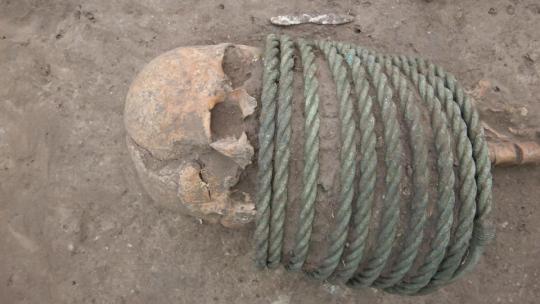
Skeletons With Rings Around Their Necks Uncovered at Ancient Cemetery In Ukraine
The discovery of a cemetery in Ukraine from a millennium ago has revealed axes, swords, jewelry and, unexpectedly, buckets around the feet of some of the dead.
Archaeologists in Ukraine have discovered a 1,000-year-old cemetery whose dead were buried with weapons, jewelry and, curiously, buckets around some of their feet.
The 11th-century cemetery is located about 50 miles (80 kilometers) south of Kyiv. Of its 107 graves, "most of the identified burials were deposed in wooden coffins," Vsevolod Ivakin and Vyacheslav Baranov, both archaeologists at the National Academy of Sciences of Ukraine, wrote in a paper they presented at the annual meeting of the Archaeological Institute of America, which was held Jan. 4-7 in Chicago.

The cemetery's dead include both men and women. Some of the men were buried with weapons, such as axes, spearheads and swords, Ivakin and Baranov wrote. A few of the women were buried with elaborate neck rings, which "are found only on necks in female burials and were apparently a kind of social marker," in this region at the time, Baranov said in an email. Some of the people were buried with wooden buckets at their feet, which may have been part of funerary rituals. Other sites that have buckets within burials have been found in the region.
The archaeologists also found a stone altar, as well as bracelets, beads and the remains of food offerings, such as chicken bones and eggshells, among other artifacts. The altar could have been used for Christian or pagan rituals, or possibly both.
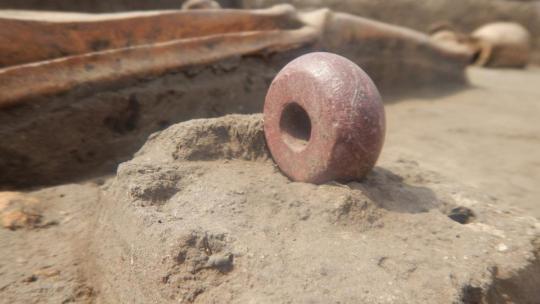
Some of the artifacts are similar to those found in the Baltic, hinting that some of the people buried in the cemetery might have come from that region to serve in the militaries of the rulers of Kyiv, such as Volodymyr the Great (who reigned from 980 to 1015) and Yaroslav the Wise (who reigned from 1019 to 1054), the archaeologists noted. The territories that Volodymyr the Great ruled stretched to the Baltic region.
At the time the cemetery was in use, people in Ukraine were converting to Christianity, the researchers said. This included Volodymyr the Great, who left behind his pagan roots and was baptized around 987 before his marriage to Anna, the sister of the Byzantine emperor Basil II.
The researchers excavated the cemetery between 2017 and 2022. The ongoing Russian invasion of Ukraine, however, has paused many excavations in Ukraine, including this one, the archaeologists said.
By Owen Jarus,
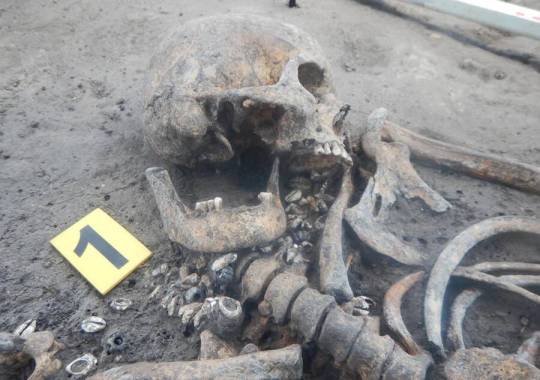
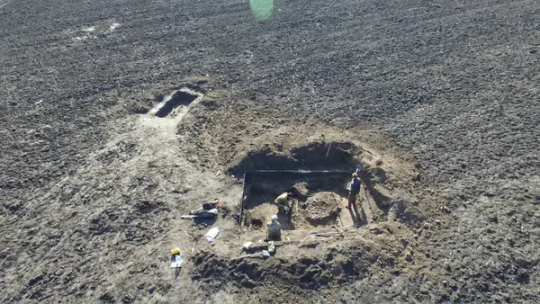
#Ukraine#Skeletons With Rings Around Their Necks Uncovered at Ancient Cemetery In Ukraine#ancient grave#ancient tomb#ancient cemetery#ancient artifacts#archeology#archeolgst#history#history news#ancient history#ancient culture#ancient civilizations
306 notes
·
View notes
Text
Nice find. I love that fretwork cartonnage. Beautifully done.
24 notes
·
View notes
Text
Unearthing Ancient DNA samples]
TEHRAN – A team of experts has extracted DNA samples from the remains of ancient humans buried in urn-like clay tombs, which were unearthed accidentally earlier this year in southwest Iran.

“The preliminary investigations show these burial urns can be dated from the Parthian and Sassanid eras, but for absolute dating, we have to wait for the results of dating tests on bone remains,” CHTN quoted archaeologist Loqman Ahmadzadeh as saying on Tuesday.

The discovery was made in the Kourosh neighborhood of Ahvaz last July when heavy machinery conducted excavations in the oil-rich region, the report said.
This rare and accidental discovery has provided an exceptional opportunity for archaeologists to conduct methodical research on the history of Ahvaz, the archaeologist said.
Ahmadzadeh added that the burial urns are of the torpedo-shaped type, whose inner surface is tarred, and the condition of the bones inside them shows a natural order and no confusion.

Among the burials, [the remains of ] a child were found…. On the forearm of its skeleton, a worn iron object was seen, which was probably the remains of a bracelet or bangle, the archaeologist noted.
In addition, samples of bitumen used in lining the inner surface of the vats will be analyzed in a laboratory to determine the origin and compare with similar cases in other contemporaneous sites, he said.
The Parthian Empire Parthian Empire (247 BC to 224 CE), also known as the Arsacid Empire, was a major Iranian political and cultural power in ancient Iran. The Parthians largely adopted the art, architecture, religious beliefs, and royal insignia of their culturally heterogeneous empire, which encompassed Persian, Hellenistic, and regional cultures. At its height, the Parthian Empire stretched from the northern reaches of the Euphrates, in what is now central-eastern Turkey, to eastern Iran.

The Sassanid era (224 CE–651) is of very high importance in the history of Iran. Under the Sassanids, Persian art and architecture experienced a general renaissance. Architecture often took grandiose proportions, such as the royal palaces at Ctesiphon, Firuzabad, and Sarvestan, which are amongst the highlights of the ensemble. In that epoch, crafts such as metalwork and gem engraving grew highly sophisticated, yet scholarship was encouraged by the state. In those years, works from both the East and West were translated into Pahlavi, the language of the Sassanians. In 2018, UNESCO added an ensemble of Sassanian historical cities in southern Iran — titled “Sassanid Archaeological Landscape of Fars Region”-- to its World Heritage list.
Ahvaz is the capital of Khuzestan province, which is home to three UNESCO World Heritage sites: Susa, Tchogha Zanbil, and Shushtar Historical Hydraulic System, among many other historical sites.
#Iran#ancient cemetery#archaeology#ancient history#Ancient Persia#Ahvaz Iran#Khuzestan#UNESCO#DNA extraction#ancient tombstone#Partian Empire#Sassanid Empire#Tehran Iran#ایران#امپراتوری اشکانی#امپراتوری ساسانی#گورستان باستانی
6 notes
·
View notes
Text
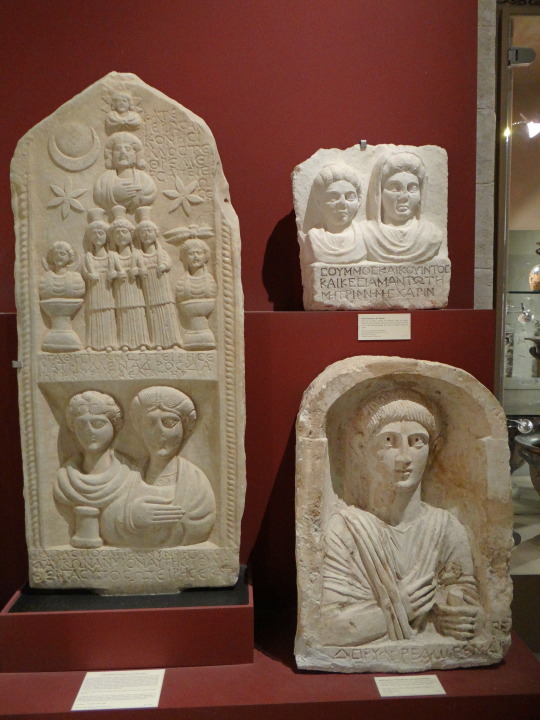
Ancient Roman tombstones.
Avignon, France.
#avignon#france#provence#ancient rome#sculpture#tomb#cemetery#original photography#photography#taphophile#taphophilia#lensblr#photographers on tumblr#tombs#museum#artifact#wanderingjana
81 notes
·
View notes
Photo
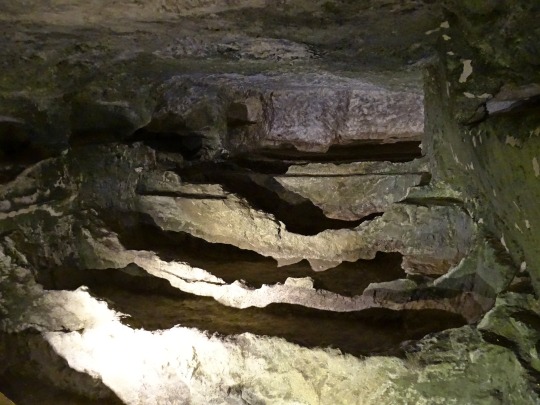


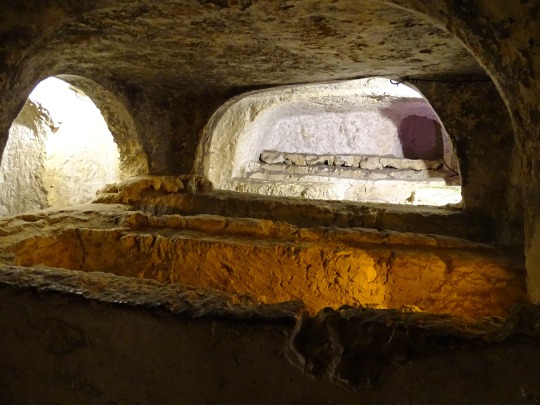
Ancient Roman catacombs of Rabat, Malta.
Check out Rabat on my website: https://wanderingjana.com/rabat
#rabat#cemeteries#tombs#malta#catacombs#ancient rome#roman#archaeology#underground#travel#history#my photos#travel blogger#original photography#wanderingjana
198 notes
·
View notes
Text

Ancient Egyptians held cats in the highest esteem.
The penalties of injuring a cat were severe and killing a cat led to capital punishment.
They worshipped a cat goddess, half woman and half feline, whom they called Bastet.
When the cat dies, it is the duty of the owners to give them proper burial along with rituals. They shave their head, eyebrows or beard to show their grief.
They even conduct after life rituals for their cat in order to gain blessings from Goddess Bastet.
Cat was embalmed with a sculpted wooden mask and then placed in the family tomb or pet cemetery (premises of Temple of Goddess Bastet) with tiny mummies of mice.
The state maintained the cats in the temple of Goddess Bastet. Head priest of the temple was in charge of maintenance of cats in temple premises.
The state also took charge of burial and rituals of stray cats.
The whole kingdom loved and respected cats. Their owners loved and treated them as their own child throughout Egyptian Civilization.
#Ancient Egypt#Ancient Egyptians#Ancient Civilization#cats#Bastet#Goddess Bastet#pet cemetery#mummies
70 notes
·
View notes
Text
A remarkable discovery at the University of Cambridge archive has unveiled a treasure trove of history. A set of 115-year-old documents, thought to have been lost for eight decades, has been found, shining a new light on the ancient Nubians!
These precious records, from early 20th-century excavations in Lower Nubia, provide invaluable insights into the ancient inhabitants of Nubia. Dr. Jenny Metcalfe, a biomedical Egyptologist from the University of Manchester, stumbled upon these "recording cards" while researching for her upcoming book.
They offer a glimpse into the Nubians' life, culture, and health.
Highlights:
• Integration of Nubians and Egyptians thousands of years ago.
• Identification of a 2,600-year-old statue of a Kush ruler.
• Grafton Eliot Smith's pioneering role in Nubian excavations.
• Over 150 cemeteries with 20,000 graves explored.
The ancient Nubians, a pioneering culture in Africa, are often overshadowed by their Egyptian neighbors. These excavations and the rediscovery of the recording cards emphasize their significant role in history.
"This discovery adds significantly to our understanding of life in ancient Nubia," says Dr. Metcalfe. "It helps us reconstruct the lives and communities of these fascinating people."
34 notes
·
View notes
Text
So the eight hero(ine) (the ancient hero??) helped the Gerudo of ancient times in a time of need but was denied entry to the city, which the seven heroines regretted… And then now Link came to help the Gerudos again, but was this time, he is allowed to get inside the city which everyone is fairly happy about… mmhh… Mmhh…
#parallels…#totk#Lithi plays totk#for obvious reasons (the cemetery in the Gerudo depths) I can only assume#that the monster the seven heroines fought was the giant gibdo Riju and Link fought#which would AGAIN draw a parallel between both stories#but also. the elephant in the room#the ancient hero’s GERUDO RED ASS hair#this is driving me MAD#the legend of zelda: tears of the kingdom#the legend of zelda: tears of the kingdom spoilers#tears of the kindom spoilers#tears of the kingdom#Seven heroines#eight heroine#totk ancient hero#ancient hero’s aspect#Gerudo
107 notes
·
View notes
Text






The eeriness of the places left behind // part 2.
#summer#july#forests#woods#summer forests#summer woods#summer fields#cemetery#ancient cross#abandoned places#abandoned villages#summer landscapes#summer scenery#summer aesthetic#summer photography#summer cottagecore#cottagecore#cottagecore aesthetic#nature#nature aesthetic#naturecore#nature photography
44 notes
·
View notes
Photo
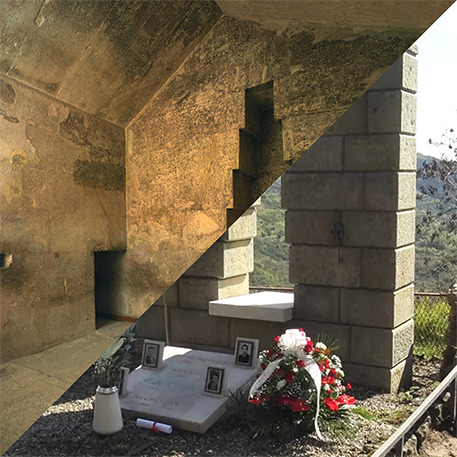
Queen’s Chamber | Great Pyramid of Giza, Egypt, 2570 BC
VS
BBPR, Tomb of Rocco Scotellaro, Tricarico, Italy, 1957
#pyramid#giza#egypt#ancient egypt#archaeology#stone#rocco scotellaro#bbpr#architecture#grave#tomb#basilicata#carlo levi#adriano olivetti#contemporary architecture#cemetery
55 notes
·
View notes
Text
A theory about Lhutel and Ensha

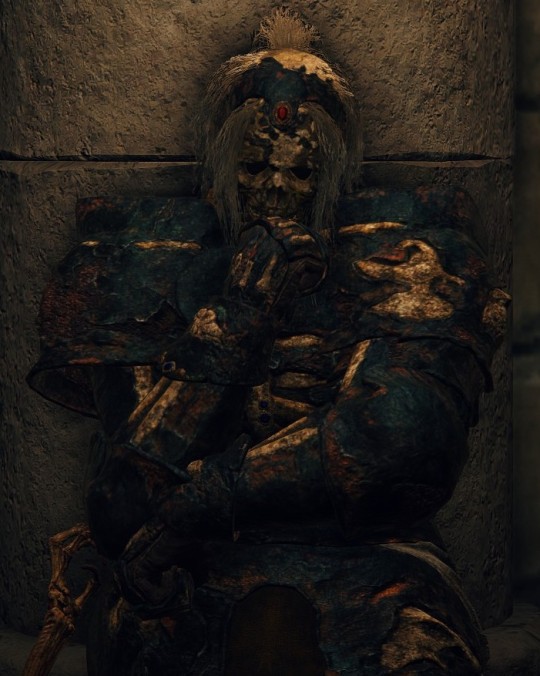
In the Weeping Peninsula Lhutel is found in the Tombsward Catacombs, dropped by a Cemetery Shade. Her ashes read the following:
"Lhutel sacrificed her life so that in Death she could continue to protect a soulless demigod until their revival, earning her the hero's honor of Erdtree Burial."
If her ashes are held by the Cemetery Shade, she is protecting nothing, at least not in ashes form. So how is this meant to be interpreted - did she fail in her duty and become captured by the Cemetery Shade? Was her spirit improperly severed from the body and the body in Erdtree burial was corrupted by decay caused by insects? Is she on another plane of existence protecting the soul of the soulless demi-god before we gain the allegiance of her headless form?
Anyways, it is one of my less grounded theories that the soulless demi-god who Lhutel is meant to protect is "Ensha", but also not exactly the Ensha who is in the service of Gideon. The Royal Remains armour set includes bones studded with gemstones in a manner that is reminiscent of the Catacomb Saints of 16th and 17th century Catholicism. Essentially what happened is that some people in the 1500's stumbled on a Roman catacomb dating to the 3rd century and the Catholic Church declared that all of the bones were holy relics belonging to martyrs, regardless of who they actually belonged to. Literally, they couldn't know whose bones were in the mix - they just wanted more holy relics to inspire the faithful.
Royal Remains
"It is said that the bones belong to an ancient lord - the soulless king. The lord of the lost and desperate, who was known as Ensha."
So, the convoluted theory is that an unplundered catacomb dating to the time of Nokron & Nokstella was discovered relatively recently and believed to hold the ancient soulless demigod, and the mausoleum knights were formed to guard the tomb. Or multiple speculated tombs. But despite their best efforts, some guy plundered the catacomb, declared that he found the bones of "soulless king Ensha", fancied them up and crudely fashioned them into an armor set, and told everyone to call him "Ensha" now. Even if he did find a full and correct set of bones, he probably doesn't even have the original head, because it is a trend with the mausoleums that "soulless" is equated with "headless".
It is also my guess that the soulless demi-god referenced by Lhutel's Ashes and the soulless "Ensha" could be Miquella's soulless companion mentioned by the spirit at Castle Sol. Either that, or Miquella fancies himself king Ensha reborn and his soulless companion is a contemporary from the ancient time of Ensha.
This would make sense of false Ensha attacking when half of the Haligtree medallion is obtained. But regardless, it is strange to me that this dialogue is so often thought to be referring to the soulless Godwyn, when Golden Epitaph reads that Miquella wants Godwyn dead forever. Of course for this whole interpretation it would need to be accepted that the soulless demigods actually placed in the Walking Mausoleums are a red herring - they are Marika's unwanted children after all, so why resurrect them?
#elden ring#elden ring lore#analysis of art design#media analysis#ties into the theory that Miquella is either a reincarnation of an ancient dead god#Or has convinced himself that he is some kind of Hermes Trismegistus but isn't#St. Trina and Trismegistus both start with prefix tri- meaning three#Also thinking of how the cemetery shade model is a head crab
11 notes
·
View notes
Text

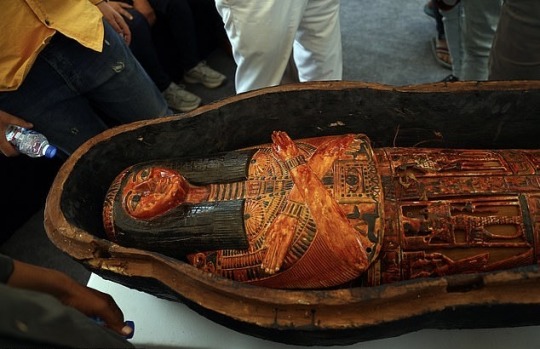

3,400-Year-Old Ancient Egyptian Cemetery Found With Colorful Coffins
Archaeologists have uncovered an Ancient Egyptian cemetery dated to more than 3,000 years ago containing the colorful coffin of a high priest's daughter and preserved mummies, among hundreds of other finds.
Researchers unearthed the cemetery at the Tuna el-Gebel necropolis, located almost 170 miles south of Cairo in Minya Governate, Egypt's Ministry of Tourism and Antiquities announced in a statement on Sunday.
The cemetery, which dates back to the New Kingdom (16th-11th centuries B.C.) of ancient Egypt, was used as a burial ground for senior officials and priests during the period, according to archaeologists.
The cemetery was uncovered during excavations that began last August in the Al-Ghuraifa area of Tuna El-Gebel and features "many tombs" that have been carved into rock.
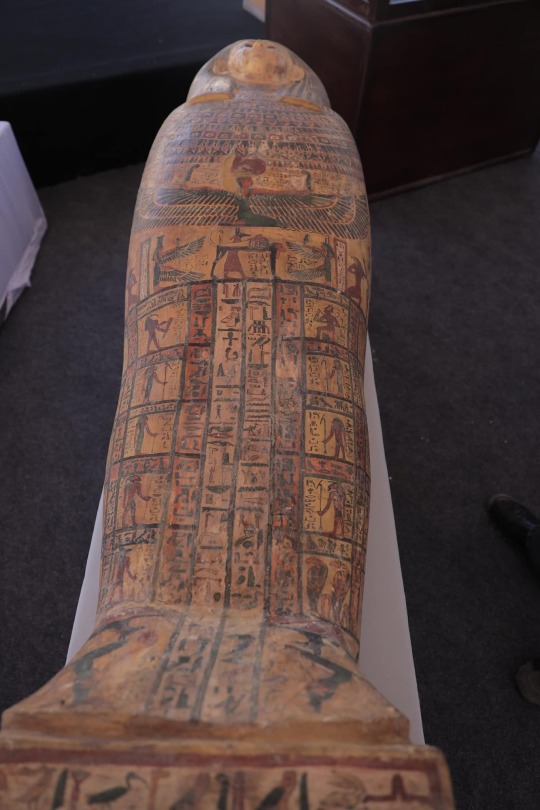
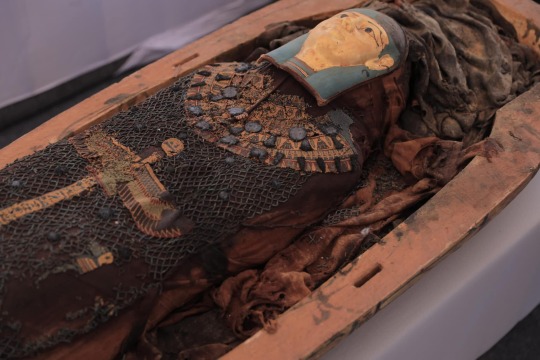
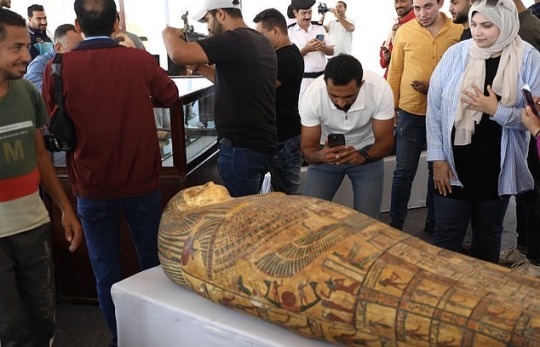
Researchers have also made hundreds of archaeological finds at the site, including stone and wooden coffins—some of which contained mummies—amulets, ornaments and funerary figurines.
One of the most notable finds at the cemetery is a colorful, engraved coffin belonging to the daughter of a high priest of the ancient Egyptian god Djehuti, often referred to as Thoth.
This deity, commonly depicted as a man with the head of an ibis or baboon, was a key figure in ancient Egyptian mythology and played several prominent roles. For example, Thoth was credited with the invention of writing and is also believed to have served as a representative of the sun god Ra.
Next to the coffin of the high priest's daughter, archaeologists found two wooden boxes containing her canopic jars, as well as a complete set of "ushabti" statues.


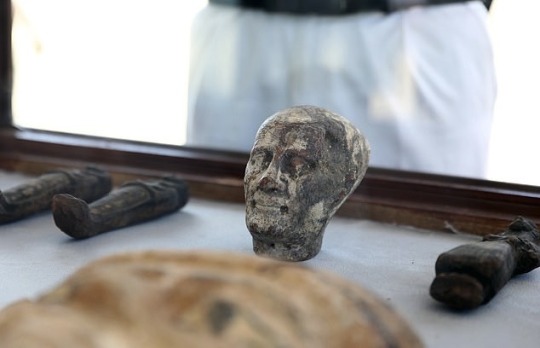
Canopic jars were vessels used by the ancient Egyptians to store the organs removed from the body in the process of mummification—the lungs, liver, intestines and stomach—in order to preserve them for the afterlife.
Ushabti statues, meanwhile, were figurines used in ancient Egyptian funerary practices that were placed in tombs in the belief that they would act as servants for the deceased in the afterlife.
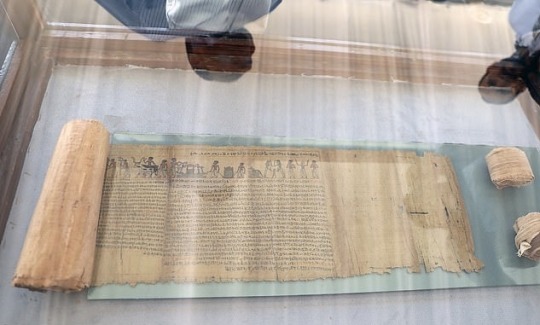

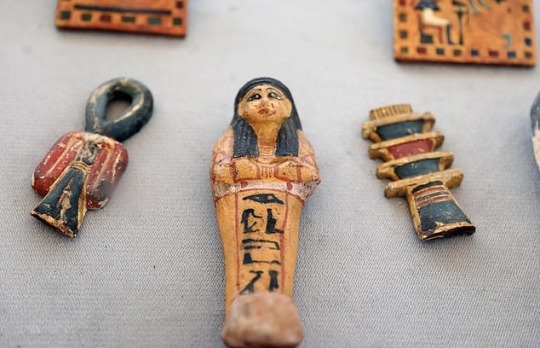

Archaeologists also made another particularly fascinating find at the New Kingdom cemetery: a complete and well-preserved papyrus scroll measuring approximately 42-49 feet in length that features information related to the Book of the Dead.
The Book of the Dead is a collection of ancient Egyptian funerary texts consisting of spells or magic formulas that were placed in tombs. These texts were thought to protect and aid the deceased in the afterlife. They were generally written on papyrus, a material similar to thick paper that was used as a writing surface in ancient times.
Mostafa Waziri, secretary general of the Supreme Council of Antiquities, said in the statement that the discovery of the cemetery is an "important" find.
By Aristos Georgiou.

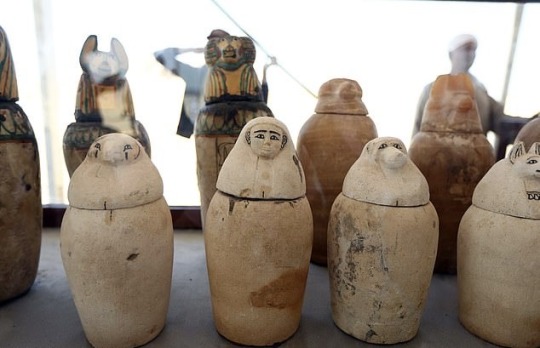
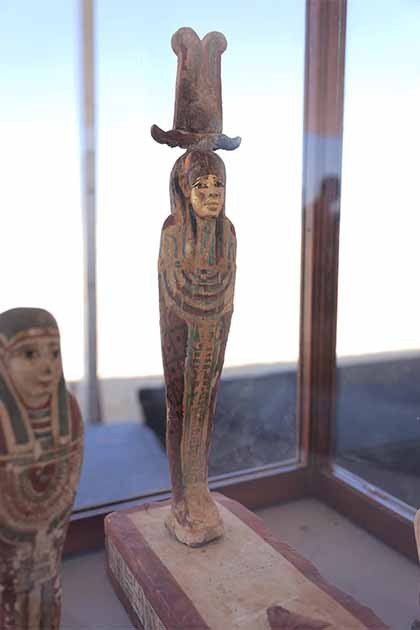

#3400-Year-Old Ancient Egyptian Cemetery Found With Colorful Coffins#Tuna el-Gebel necropolis#Minya Governate#ancient grave#ancient tomb#ancient cemetery#ancient necropolis#book of the dead#canopic jars#Egyptian god Djehuti#high priest#high priestess#ancient artifacts#archeology#archeolgst#history#history news#ancient history#ancient culture#ancient civilizations#ancient egypt#egyptian history#egyptian gods#egyptian mythology#egyptian art
181 notes
·
View notes
Text
Very nice, but they don't say why they know the woman is an aristocrat. Frustrating.
4 notes
·
View notes
Text
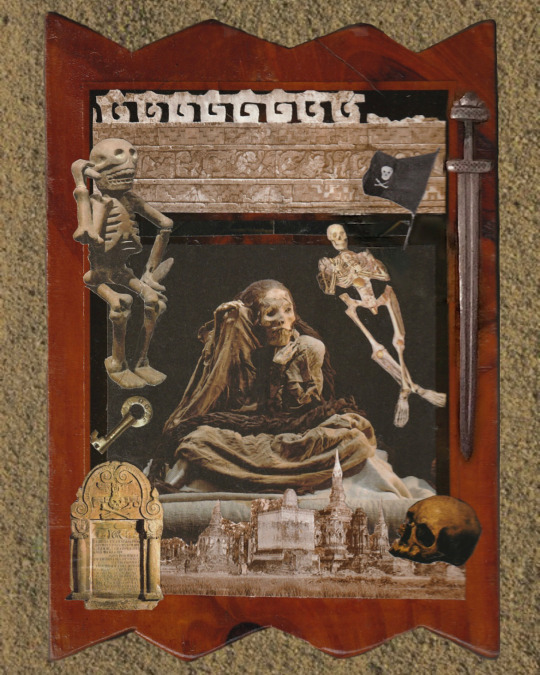
du berceau au tombeau, 2023. paper collage on wood by Elysian Fields
#art#art history#artists on tumblr#books & libraries#museums#analog collage#collage art#paper collage#history#pompeii#roman art#greek mythology#skeleton#dagger#cemetery#ancient history#ancient art#mythology and folklore#analog#paper art#collage artist#physical art#mixed media#gothic art#gothic#ghost#pirates#mystical#my art#original art
7 notes
·
View notes
Text

Ancient Roman sarcophagus featuring some Greek theater scenes.
Louvre, Paris.
#ancient rome#ancient roman#sarcophagus#tomb#cemetery#original photography#photography#lensblr#photographers on tumblr#taphophile#taphophilia#tombs#paris#museum#france#louvre#wanderingjana
17 notes
·
View notes
Text

hello, I am a new blog to share the beauty that grows from what is left behind. looking for mutuals 🪦
#cemetary#death is not the end#beauty#mossy posts#mossy forest#cemetery photography#reposts#green aesthetic#abandoned#ancient#headstone#abandoned cemetery#abandoned church#historic cemetery#historic site#overgrown#plant posting#naturecore#haunting#angel#angel core#dark aesthetic#moody#moody photography#aesthetic#followers#follower train#follow me#dark green#green posts
14 notes
·
View notes